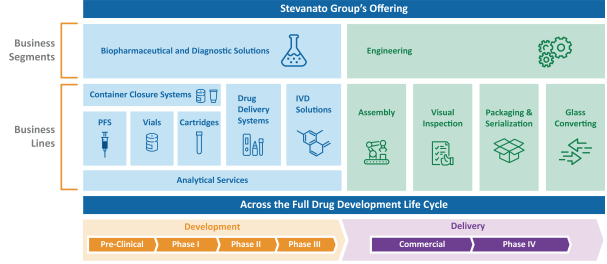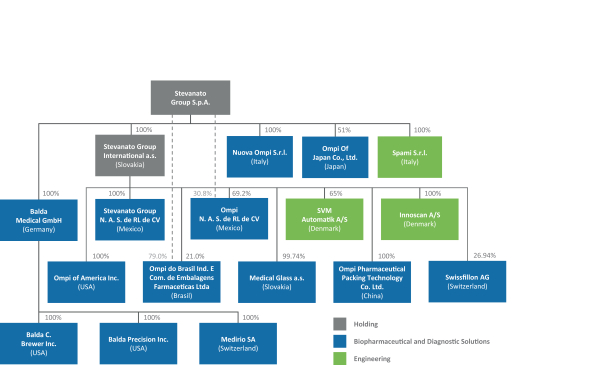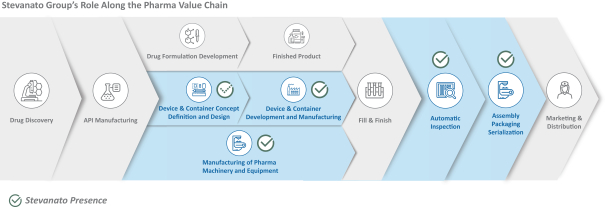The information in this prospectus is not complete and may be changed. These securities may not be sold until the registration statement filed with the Securities and Exchange Commission is effective. This prospectus is not an offer to sell nor does it seek an offer to buy these securities in any jurisdiction where the offer or sale is not permitted.
PRELIMINARY PROSPECTUS
SUBJECT TO COMPLETION, DATED July 12, 2021
STEVANATO GROUP S.P.A.

40,000,000 ordinary shares
This is an initial public offering of 40,000,000 ordinary shares without par value in the capital of Stevanato Group S.p.A. (“Shares”) by Stevanato Group S.p.A. We are offering 28,000,000 ordinary shares. The selling shareholder identified in this prospectus is offering an additional 12,000,000 ordinary shares.
We currently estimate that the initial public offering price will be between $21.00 and $24.00 per share. Prior to this offering, there has been no public market in the United States, or the U.S., for our Shares. Application has been made for the listing of our ordinary shares on the New York Stock Exchange (“NYSE”) under the ticker STVN. We believe that upon completion of the offering contemplated by this prospectus, we will meet the standards for listing on the NYSE’s main exchange.
We have two classes of shares, ordinary shares and class A multiple voting shares (the “Class A shares”, including 30,840,555 Class A shares held in treasury). Following the completion of this offering, Stevanato Holding S.r.l. will beneficially own 228,501,960 of our issued Class A shares. Holders of ordinary shares will be entitled to one vote per share, while holders of Class A shares will be entitled to three votes per share. Upon any sale, transfer, assignment or disposition of any Class A shares by a holder thereof to a non-affiliate of such holder, each of such Class A shares will be automatically and immediately converted into one ordinary share.
Following the completion of this offering, we will be a “controlled company” within the meaning of the corporate governance rules of the NYSE because Stevanato Holding S.r.l. will beneficially own 94.35% of the total voting power of our then outstanding share capital (excluding 30,840,555 Class A shares held in treasury which voting power is suspended as long as such shares are held in treasury), assuming the underwriters do not exercise their over-allotment option, or 93.53% of the total voting power of our then outstanding share capital if the underwriters exercise their over-allotment option in full. See “Principal and Selling Shareholder” beginning on page 130.
We are both an “emerging growth company” and a “foreign private issuer” as defined under U.S. federal securities laws and as such, will be eligible for reduced public company reporting requirements for this prospectus and future filings.
Investing in our shares involves risks. see “Risk Factors” beginning on page 21.
Neither the United States Securities and Exchange Commission nor any other regulatory body has approved or disapproved of these securities, or determined if this prospectus is truthful or complete. Any representation to the contrary is a criminal offense.
PRICE US$ per Share
| Price
to |
Underwriting |
Proceeds |
Proceeds
to |
|||||||||||||
| Per ordinary share |
$ | $ | $ | $ | ||||||||||||
| Total |
$ | $ | $ | $ | ||||||||||||
| (1) | See the section entitled “Underwriting” for additional disclosure regarding underwriting compensation payable by us. |
To the extent that the underwriters sell more than 40,000,000 of our ordinary shares, we and the selling shareholder have granted the underwriters the right to purchase up to an additional 6,000,000 ordinary shares at the same price as the ordinary shares offered through this prospectus, for 30 days after the date of this prospectus.
The underwriters expect to deliver the ordinary shares against payment in U.S. dollars in New York, New York on or about , 2021.
| MORGAN STANLEY | BofA SECURITIES | JEFFERIES |
| CITIGROUP | UBS INVESTMENT BANK |
KEYBANC CAPITAL MARKETS | WELLS FARGO SECURITIES |
WILLIAM BLAIR |
Prospectus dated , 2021.











